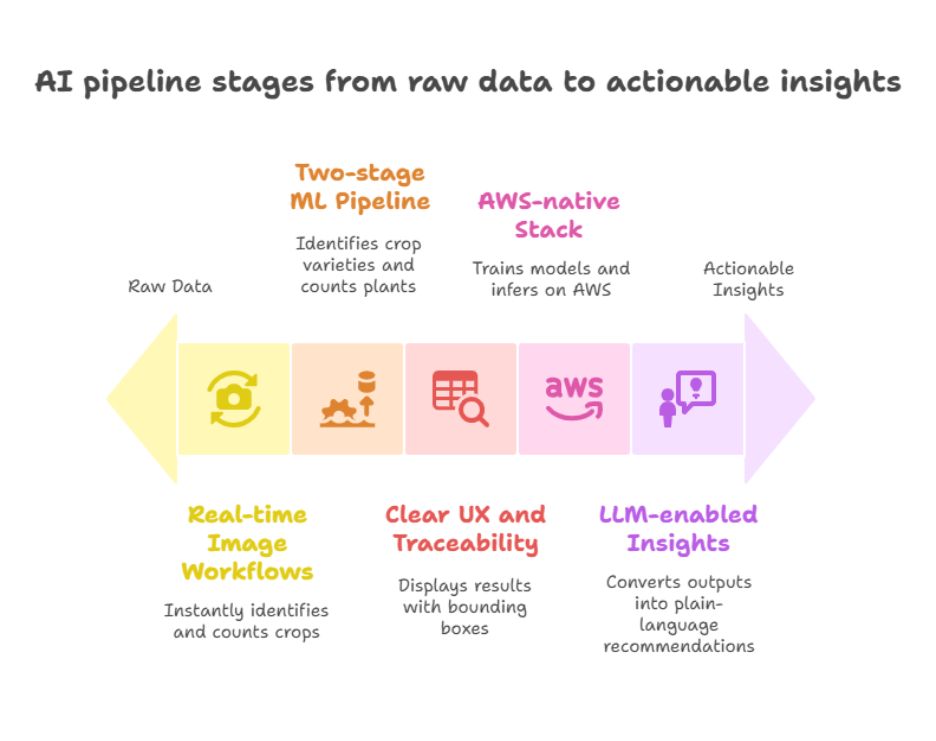Druid, a precision agriculture innovator, set out to enhance farmers’ decision-making with real-time, AI-driven crop insights. While their IoT cameras and telemetry sensors continuously captured high-quality field data, the company lacked the ability to accurately identify crop types and count their presence, critical capabilities for optimizing agricultural practices and predicting yields.
The problem: missing crop intelligence in a data-rich environment
Despite having an advanced IoT and AWS-based data infrastructure, Druid faced a critical gap in applying AI in agriculture to transform raw field data into actionable intelligence. Their IoT cameras continuously captured high-resolution images of crops, while telemetry sensors recorded environmental data such as temperature and humidity in near real time. However, without a robust AI system to accurately identify specific crop types and count their presence, this data remained underutilized.
The inability to perform automated crop recognition and quantification meant farmers had to rely on manual methods, slow, labor-intensive processes that delayed decision-making and limited opportunities to optimize yield predictions, resource allocation, and sustainable farming practices. This gap underscored the urgent need for a proof of concept demonstrating how AI in agriculture could deliver fast, accurate, and scalable crop insights in controlled conditions.
The solution: a computer-vision pipeline for crop identification and counting
To address Druid’s gap, GoML and Druid co-developed a focused, production-ready-style PoC: a lightweight, secure computer-vision system that turns single, well-lit images into actionable crop intelligence.
Real-time image workflows
Farmers upload images via a Streamlit UI; the system runs identification and counting instantly without BI or ML team support.
Two-stage ML pipeline
CNN/VLM model for identifying 10 crop varieties + object detection for counting plants in single-variety images, each with confidence scores.
Clear UX and traceability
Streamlit displays results with bounding boxes; all inferences and metadata are stored in S3 for audit and correlation.
AWS-native stack
Training in SageMaker; inference pipeline on AWS; telemetry data in DynamoDB for future analytics.
LLM-enabled insights
Claude 3.7 via Bedrock converts outputs into plain-language recommendations for future conversational use.
Security and knowledge transfer
AWS encryption, IAM controls, SME validation, end-to-end testing, and detailed handover documentation.

The impact: faster insights, smarter farming decisions
Druid’s computer vision ML and AI PoC isn’t just another image recognition tool, it’s an always-on, always-learning crop intelligence assistant.
- 80%+ accuracy in identifying selected crop varieties under controlled conditions
- 90% reduction in time-to-insight, from days/weeks to seconds/minutes
- 100% traceability of inferences with full image and metadata storage in Amazon S3
The system has redefined how Druid's agronomy teams interact with field data, turning single images into actionable insights in seconds, not hours.
Lessons for precision agriculture teams
Common pitfalls to avoid
- Skipping controlled testing before scaling AI models
- Overloading PoCs with production-grade complexities too soon
- Ignoring image quality during data collection
Advice for agritech leaders
- Start with a small, measurable PoC
- Leverage existing IoT infrastructure before building from scratch
- Make results accessible through intuitive interfaces
Ready to bring AI in agriculture to your fields?
Let GoML help you design and deploy computer vision ML and AI solutions, from PoC to production, just like we did with Druid. Reach out today to explore your own AI-powered transformation.





